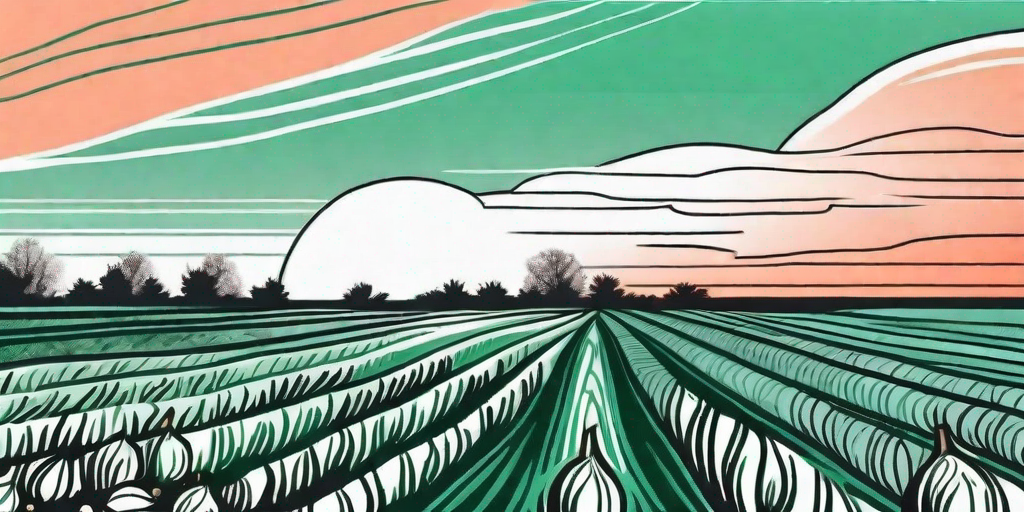
Onions are the unsung heroes of the culinary world, adding depth and flavor to countless dishes. But when it comes to harvesting these tear-jerking gems, timing is everything. Get it wrong, and you could end up with a crop that's more fit for the compost heap than the kitchen. But fear not, dear reader, for we are here to guide you through the onion harvesting process, ensuring you get the most from your crop.
Understanding the Onion Life Cycle
Before we dive into the nitty-gritty of onion harvesting, it's important to understand the life cycle of this humble vegetable. Onions are biennial plants, which means they complete their life cycle in two years. However, we usually harvest them in their first year, when they're in their prime.
The life cycle of an onion begins with planting, usually in early spring. The plant grows leaves and a bulb during the warmer months, storing energy in the bulb for the following year. If left in the ground, the onion would use this stored energy to flower and produce seeds in its second year. But we're not here for the flowers, are we? We're here for the bulbs!
Signs That Your Onions Are Ready for Harvest
Falling Over Tops
One of the first signs that your onions are ready to be harvested is when the tops (or leaves) of the plant start to fall over. This is the onion's way of telling you that it has stopped growing and is ready to be plucked from the earth. However, don't be too hasty! Just because the tops have fallen over doesn't mean it's time to grab your gardening gloves just yet.
Once the tops have fallen over, it's recommended to leave the onions in the ground for another 7 to 14 days. This allows the onions to mature fully and their outer layers to dry, which helps in preserving them for longer periods.
Bulb Size and Color
Another indication that your onions are ready for harvest is the size and color of the bulb. Mature onions typically have a bulb that's at least 3 inches in diameter. The color of the bulb can also give you a clue. If you're growing white onions, the bulb should be, well, white. If you're growing red or yellow onions, the bulb should be a vibrant red or yellow.
Remember, though, that these are just guidelines. The size and color of your onions can vary depending on the variety you're growing and the conditions in your garden. When in doubt, it's better to harvest a little early than too late.
How to Harvest Your Onions
Now that you know when to harvest your onions, let's talk about how to do it. Harvesting onions is a relatively simple process, but there are a few tips and tricks that can make it even easier.
First, gently loosen the soil around the onion with a garden fork or trowel. This makes it easier to pull the onion out of the ground without damaging the bulb. Once the soil is loosened, grasp the onion by the base of the leaves and gently pull. If the onion doesn't come out easily, don't force it. Instead, use your garden tool to dig around the onion and lift it out of the ground.
Post-Harvest Care
Once you've harvested your onions, the work isn't over. Proper post-harvest care is crucial to ensure your onions last as long as possible.
After harvesting, leave your onions in a well-ventilated, shady spot to dry for two to three weeks. This process, known as curing, helps to dry out the outer layers of the onion, protecting the inner layers from rot and extending the onion's shelf life.
Once your onions are cured, trim the tops to about one inch and remove any loose or dirty outer layers. Store your onions in a cool, dry, well-ventilated area. Properly stored onions can last for several months.
FAQs
Why are my onions small?
Several factors can contribute to small onions, including planting too closely together, inadequate watering, and poor soil nutrition. To ensure large, healthy onions, give them plenty of space to grow, water regularly, and enrich your soil with compost or a balanced fertilizer.
Can I eat onions straight from the garden?
Yes, you can eat onions straight from the garden. However, if you plan to store them, it's best to cure them first to extend their shelf life.
What happens if I leave my onions in the ground too long?
If left in the ground too long, onions can start to rot or sprout new growth. To avoid this, keep an eye on your onions and harvest them when they show signs of maturity.
Conclusion
Harvesting onions at the right time can make the difference between a good crop and a great one. By understanding the onion's life cycle, knowing the signs of maturity, and following proper harvesting and post-harvest care techniques, you can ensure a bountiful and delicious onion harvest. So say goodbye to tears (unless you're chopping them, of course) and hello to the joy of perfectly timed onion harvesting!











